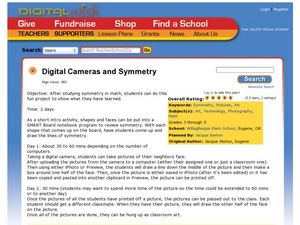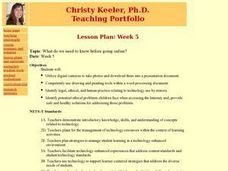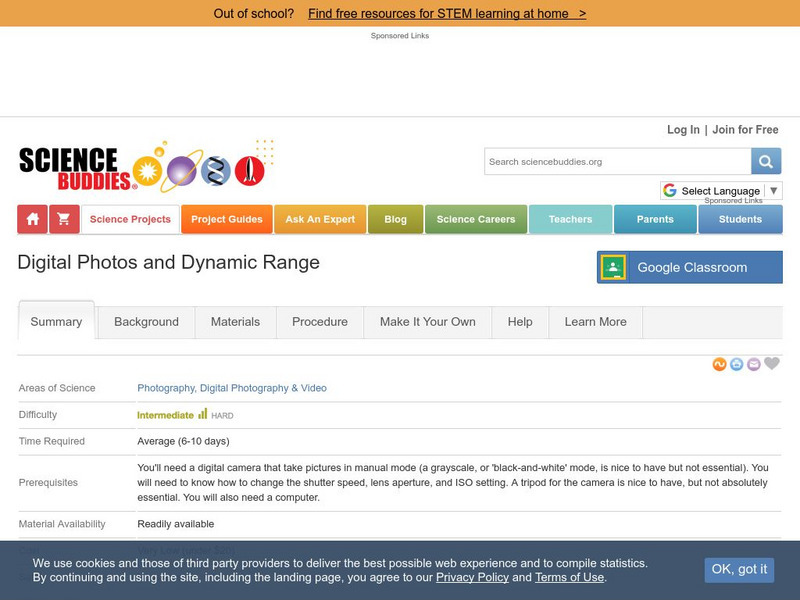Curated OER
Your Neighborhood Geography
Tenth graders observe geographical characteristics of their own neighborhoods. They take digital pictures and write a summary of the geographical features they find which they present to the class.
Curated OER
African Animals in Habitats
Young scholars investigate animal habitats in zoos. In this animal habitat lesson plan, students fill in a KWLH chart about zoos before looking at pictures of African animals in zoo habitats. They discuss what they see and take a field...
Curated OER
Using Our Senses
First graders explore the five senses. For this five senses lesson, 1st graders use digital cameras to take pictures of things in nature they can hear, smell, see, taste or touch. Students create a slideshow and present to the community.
Curated OER
Digital Cameras and Symmetry
Students take pictures of shapes and faces they see and draw lines of symmetry in them. In this symmetry lesson plan, students also draw one half of another student's face.
Curated OER
Digital Cameras and Numbers
Students take pictures with digital cameras of items they count and letter formations they make. In this numbers and letters lesson plan, students present their photographs in iPhoto on the computer.
Curated OER
Seed to Plate
Students record the development of a garden on digital cameras and research the nutrition that comes from growing food in a garden. In this garden and nutrition lesson plan, students also explain to younger students the importance of...
Curated OER
Math All Around Us!
Young scholars find math concepts in every day items. In this math concept lesson, students take ten photographs of things they find interesting. They analyze the photographs to find hidden math concepts such as counting, lines, angles,...
Curated OER
Treasure Hunt with cameras
Students complete a treasure hunt with digital cameras. In this technology instructional activity, students look for items specific to content and they photograph them with their digital camera. They upload the pictures to create...
Curated OER
Living / Non-living
First graders shoot photographs of living and non-living things. In this living and non-living organism lesson, 1st graders discuss the attributes of living things, take digital photographs of living and non-living things, and design a...
Curated OER
Van Gogh Self-Portrait
Students explore using digital cameras to take their own photograph and then download them to the school's Dell computers. They then utilize the Tool Factory Workshop program to manipulate the photograph to only a few basic colors and...
Curated OER
Using A Digital Camera With HyperStudio
Students take and import pictures for use in a testing template, one page for each of the four basic functions of math. Students interact with an already designed HyperStudio template to develop a test of basic math skills.
Curated OER
What do we need to know before going online?
Students explore, examine and study about digital cameras, downloading photos, painting tools, word processing and identifying legal, ethical and human practice relating to technology use by minors. They identify potential ethical...
Curated OER
Community Connections
Eighth graders with a number of disabilities visit people and places in their community while using digital cameras to record their visits. They take digital pictures which they include in books, posters, and other publications which...
Curated OER
Geometric Figures
Students identify two and three dimensional shapes and use appropriate geometric vocabulary to write a description of the figure by taking pictures of geometric figures in their own environment.
Curated OER
Use of Digital Cameras
Students become familiar with the operation of the school digital camera. They insert photographs into WORD procession software and use text boxes and arrows to create labels.
Curated OER
Use of Digital Cameras
Students make observations of frogs by taking pictures of a frog and writing about its structual and behavioral characteristics. They insert a photo in Word and add text boxes and arrows for labeling.
Curated OER
Use of Digital Cameras - Instruction And Practice
Fourth graders explore the use of digital cameras to record daily classroom activities. They place their pictures into a folder that they created. They make a word document that includes one of the pictures that they took.
Curated OER
Calendars - Teaching Kids Economics
Students study economic terms and create a calendar using digital cameras. They advertise the calendar to the whole student population by making posters and singing an advertising jingle.
Science Buddies
Science Buddies: Digital Photos and Dynamic Range
Digital cameras can be a great way to learn about photography. Most digital cameras today have LCD screens, so you get instant feedback on your photo. If you make a mistake, no problem, you just delete the picture. It's nice that you...
Other
Short Courses: Digital Cameras and Digital Photography
This page on shortcourses.com provides links that will answer all of your questions regarding digital cameras and digital photography. Some topics include: using your digital camera, editing digital photos, choosing a digital camera, and...
Other
Digital Photography Preview
Digital Photography Preview is a website that includes news, reviews, a timeline, a buying guide, galleries, forums, a glossary, and much more dealing with digital cameras and photography.
Other
The Working Reporter: A Resource for Journalists
A great all-in-one news site, the Working Reporter provides national and international news, updated constantly with a running ticker so you can add to your own Web page for free.
National Museum of Science and Industry (UK)
Ingenious: Image Manipulation
Experience an interesting interpretation for the manipulation of photographic images. Manipulation is used widely in advertising, politics, and in exploiting ones personal character.
Science Buddies
Science Buddies: Measuring Velocity With a Video Camera
A video camera records 30 "frames" or distinct images per second. (That's for an NTSC camera in the U.S. PAL cameras in other areas of the world take 25 frames per second.) You can use this fact to time events and measure velocity. One...

























